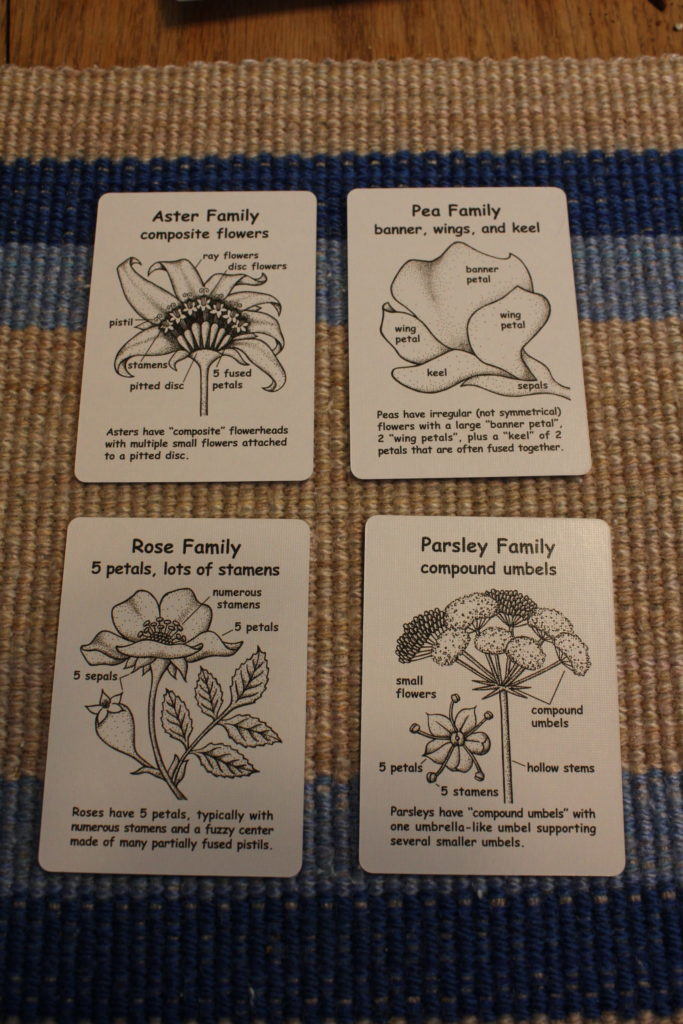Are you puzzled by Parsley, perplexed by Peas, grouchy about Grasses, angry about Asters, raging at Roses, and mad at Mints? Are you just plain flummoxed by flowers? Have you ever wished there was a fun and easy way to learn–or to teach others–about eight of the most common plant families?
Learning a few of the most common basic plant families can at least get you into the right ballpark for the vast majority of plants you’ll find when you are outside trying to identify plants. From there, you can learn the finer points of plant identification, but you need to be able to at least get to the right family to start.
With so many people trying to learn wildcrafting and foraging right now, and so much terribly wrong information being offered online, it is more important than ever to be able to spot an incorrect plant identification. Eating or otherwise ingesting an incorrectly identified plant could be fatal or do lasting damage to you or a loved one. Or you might just be able save some clown on the internet who thinks that flower color alone is enough to go on to offer an ID and some edibility advice. I’ve seen some truly awful identifications and advice lately with so many people spending more time online, and some of that advice is just plain dangerous and scary.
I might have a solution to help keep you from Aster disasters. I recently purchased a card game called Shanleya’s Quest from HOPS Press. It goes along with the Shanleya’s Quest book about a girl who learns about plant families in the process of fulfilling a quest. The game was developed by the same folks who published the book Botany in a Day, and is based on the same teaching principles.

Today is its first day out of the box, and I’ve already used it on a long distance Zoom session with my niece, who seemed to learn from it very quickly! She missed very few families as we talked about each card turned over in a simple matching game. At ten years old, she beat me soundly, owing to her superior memory for objects in a grid. Throw me into a field and I’ll take you directly to a plant I saw last week, but a uniform grid of identical card backs does nothing for my memory circuits. There, the ten year old proved vastly superior! It’s a good thing I’m a cheerful loser.
The game can be played with or without reading the book, and the deck of cards comes with instructions for five different games, or can simply be used as a set of flashcards.

Family cards give brief details of key features of a family of plants with a line drawing of a typical family member. Colorful flower cards show photos of actual plants from the eight families covered. Some are quite obvious, while others are a bit trickier to place in the correct family.

This is a great “stay in” game for those longing for some flower time, but stuck inside right now. I think young children can learn the families if they are given a personal introduction via the family cards. For the long distance game we played, I emailed my niece two photos of just the black and white family cards, for her to familiarize herself with the families ahead of time. An hour later, she was all studied up and ready to win.
I highly recommend this game for anyone wanting to know more about identifying flowers and just beginning, and also for anyone trying to entertain a child at home indoors.
Just so you know, I have no connection with the company that produces and sells the game. I just like investigating new learning tools, and I’ll be adding this to my list of ways to teach about plants. Meanwhile, I had a fun hour with my niece, and when I asked her if we could play something via Zoom again sometime, she said “Absolutely!” I guess she had a good time, too.
Try it, master it; and you’ll be pleased by Peas, remembering Roses, plucky about Parsley, loving Lilies, marveling over Mints, and great with Grasses.
And, when you can all walk around freely again, take a walk and see how many plants you can match up with the eight families you learned.